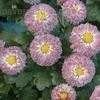





 If you are planning to try to overwinter a chrysanthemum, there is one very important distinction to be made as to the type of plant you have. The decorator mums widely available in September and October are usually winter-hardy varieties. With a bit of protection, these hardy mums will perennialize in your garden. But if your chrysanthemum comes from a florist, the plant is most likely a greenhouse cultivar, bred especially for looks rather than hardiness. These mums are difficult to grow outside a greenhouse and are best treated as annuals if planted outside.
If you are planning to try to overwinter a chrysanthemum, there is one very important distinction to be made as to the type of plant you have. The decorator mums widely available in September and October are usually winter-hardy varieties. With a bit of protection, these hardy mums will perennialize in your garden. But if your chrysanthemum comes from a florist, the plant is most likely a greenhouse cultivar, bred especially for looks rather than hardiness. These mums are difficult to grow outside a greenhouse and are best treated as annuals if planted outside.1. Water mums daily while they're blooming. The potted mums you buy in the fall dry out quickly since they are usually top heavy with bloom and have a relatively small amount of roots. Keeping the soil moist will help plants stay healthy until you are ready to plant them.
2. Get mums out of their pots and into the ground soon after purchase. This gives the roots the maximum amount of time to become established before a hard freeze. If you prefer to display mums in the pots they came in, plant them promptly once their flower display is done.
3. Don’t cut back the foliage of mums in the fall. The above-ground growth offers the plant an extra layer of winter protection. It also serves as a good reminder in the spring to search for any healthy new root growth under the ground. If you feel you must trim off something, remove the spent flowers only, but leave the rest of the plant alone.
4. Provide mums with a generous layer of a light mulch as soon as the ground freezes. Mounding pine needles, straw or evergreens around the plant will help prevent the roots from heaving out of the ground during repeated freeze/thaw cycles. If using leaves, be sure they are shredded so they won't form a sodden mat over the plant.
5. Try to create a microclimate in which the plants will be protected from winter winds. A location on the south side of a building or other sheltered spot is ideal. You can also protect potted mums by planting them in a cold frame.
6. Continue watering mums even after their blooms have faded to encourage new root growth. Keep in mind however, that mums demand good drainage. They will not survive the winter if planted in soggy soil.
Don’t expect every single plant to make it through the winter. Overwintering potted mums planted at the end of the season is something of an experiment in cold climates. Your success rate will depend on your horticultural zone, planting site and the severity of any particular winter. Also keep in mind that even though a chrysanthemum plant is labeled “hardy”, some varieties are undoubtedly more cold-resistant than others.
Planting in the Spring Your mums will look more dead than alive come spring. Once the soil is warm enough to be worked, dig up the plants and discard all the brown plant material. (Finally, you can trim off that old foliage!) Save only the stolons showing green shoots, and plant them in a sunny location in rich, well-amended soil with good drainage. Even a few green shoots will produce a full-sized plant after a summer-long growing season. As soon as the new growth reaches 4 to 6 inches in height, pinch the stems back to encourage fullness. Besides pinching, mums also require regular watering and fertilizing. If you keep mums from year to year, you will need to rejuvenate them by resetting them annually or at least every other year.
Your mums will look more dead than alive come spring. Once the soil is warm enough to be worked, dig up the plants and discard all the brown plant material. (Finally, you can trim off that old foliage!) Save only the stolons showing green shoots, and plant them in a sunny location in rich, well-amended soil with good drainage. Even a few green shoots will produce a full-sized plant after a summer-long growing season. As soon as the new growth reaches 4 to 6 inches in height, pinch the stems back to encourage fullness. Besides pinching, mums also require regular watering and fertilizing. If you keep mums from year to year, you will need to rejuvenate them by resetting them annually or at least every other year.
Advantages and Disadvantanges of Overwintering
I call the potted mums that make it through the winter my “surprise” mums. I can never decide which mum colors I like best, so I usually end up buying a rainbow of pink, lavender, red, bronze, yellow, gold and white for fall decorating. By the time I’ve uncovered and/or replanted several winter survivors in the spring, I don’t remember what color flowers any particular plant will produce. It’s a lovely surprise in the fall when each mum’s tightly closed buds finally open to reveal their color. Because these flowers have developed in my garden instead of being forced into bloom at a nursery, they seem to be extra tough. The fact that I have pinched them back until mid-summer causes the mums to open late -- not before October. Having a few of them planted near my entryway ensures that neighborhood trick-or-treaters, and sometimes even Thanksgiving guests, will be greeted with the mums’ spicy scent and cheerful colors.
lavender, red, bronze, yellow, gold and white for fall decorating. By the time I’ve uncovered and/or replanted several winter survivors in the spring, I don’t remember what color flowers any particular plant will produce. It’s a lovely surprise in the fall when each mum’s tightly closed buds finally open to reveal their color. Because these flowers have developed in my garden instead of being forced into bloom at a nursery, they seem to be extra tough. The fact that I have pinched them back until mid-summer causes the mums to open late -- not before October. Having a few of them planted near my entryway ensures that neighborhood trick-or-treaters, and sometimes even Thanksgiving guests, will be greeted with the mums’ spicy scent and cheerful colors. The blooms of my overwintered mums also seem to last longer than their counterparts grown in a nursery. An overwintered mum behaves more like a regular garden perennial whose flowers open bit by bit, than a specimen that’s been forced into full bloom.
The blooms of my overwintered mums also seem to last longer than their counterparts grown in a nursery. An overwintered mum behaves more like a regular garden perennial whose flowers open bit by bit, than a specimen that’s been forced into full bloom.
There is one downside of bringing potted autumn mums back to life, and that is simply the amount of garden real estate they require throughout the spring and summer months. Even though chrysanthemums look downright puny early in the season, they won't do well if they're crowded, meaning that you must be sure to leave a good 12 inches of space around them to accommodate their ultimate size. Their appearance is utterly unremarkable for months and months until finally in late autumn they reward you with blooms. An ideal solution to this problem, if you have enough space on your property, would be to plant your rescued mums in a sunny out-of-way spot -- but not so remote that you forget to perform spring dividing, watering, fertilizing and stem pinching. Doing so will afford you some budding autumn bloomers ready for transplant to prominent locations just as your annuals finish up in late summer.
I’ll continue to buy new mums each fall -- they’re bright, inexpensive and provide an instant pick-me-up for the front yard at a time of year when many of my garden stalwarts are looking tattered and worn. Their compact pot size allows me to squeeze a lot of color into a small space. But I’ll also keep sheltering at least a few of them through the winter and making room in my spring garden for some fall surprises. Not only do these rescued mums contribute eye-catching color in late autumn, they offer me the satisfaction of knowing that I nurtured their beauty from start to finish.
Thumbnail Photo credit: g cobb
DG Member photos thanks to:
Chrysanthemum 'Padre' by DaylilySLP
Chrysanthemum 'Red Temptress' by DaylilySLP
Chrysanthemum x morifolium 'Gretchen' by kniphofia
Chrysanthemum x morifolium 'Barbara' by dstartz
Chrysanthemum x morifolium 'Jennifer' by dicentra63
Essential Tips to Care for Shrimp Plants
Ideas For Potted Plant Gifts: Giving Potted Plants As Gifts
Overwintering Container Plants: Preparing Potted Plants For Winter
Hechtia Plant Info: Tips On Caring For Hechtia Plants
Pruning Jade Plants: Tips For Jade Plant Trimming
Copyright © www.100flowers.win Botanic Garden All Rights Reserved